New Roubo Version
Although I have yet to see and touch it in person, my long time friend Jersey Jon sent me this picture of his new copy of the new Roubo on Furniture.
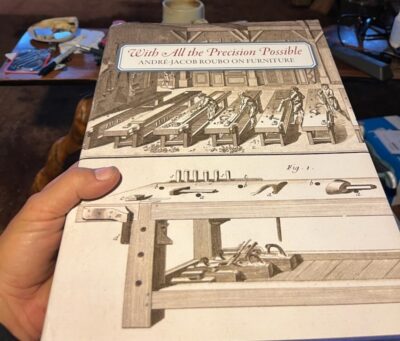
It’s not R2D2, it is R2V2.
As always. it is available over at Lost Art Press.
Although I have yet to see and touch it in person, my long time friend Jersey Jon sent me this picture of his new copy of the new Roubo on Furniture.

It’s not R2D2, it is R2V2.
As always. it is available over at Lost Art Press.
There’s been a lot of “rearrangeritis-ing” going on in the barn as I try to organize and winnow the contents so that I can establish an honest-to-goodness estimate of the footprint I need to use, in great part to project into the distant future when we build our final, geezerized home some time in the 2030s.

Back in the day when I used to write a lot for PopWood one of my articles was about building and using something I called a Butterfly Sawhorse, that could be folded flat to hang on the wall or unfolded to operate as a very convenient work or holding station (I’ll post the article as soon as Webmeister Tim and I can figure out how to unlock the AWS archive where it is stored). In the maelstrom of rearangeritis I find myself using this tool almost every day.
One of the things I’ve always wondered about the Butterfly is, how much can it carry? To be technically dispositive about it I would load it up with weights until it collapsed, documenting the process exactly. But that does not strike me as particularly useful exercise is the results would be 1) a precise knowledge of the load bearing capacity of the Butterfly, and 2) a squashed flat Butterfly.
I did get a good sense of the Butterfly’s strength recently when I loaded it up with an estimated 700 pounds of really, really green walnut. It accomplished with task with nary a quiver.
After a hiatus Michele and I are back at the Roubo grindstone. We are now looking forward to two or three or four years of near-constant work. Notwithstanding any reservations, we are determined to bring our final three sections of this monumental project to conclusion. Admittedly, if the ongoing social and political exploration of the boundaries of decadence brings about the ultimate collapse of Western Civilization, and the interwebz with it, that could be a serious glitch. As long as we can communicate easily between locations in the Virginia mountains, northern Vermont, and southern France, we will charge ahead.
In the aggregate, these three final sections — interior carpentry (windows, doors, stairs and floors); garden carpentry (surprising amounts on discussion of carving and design principles); and carriages (perhaps the coolest content of the whole encyclopedia) — are roughly 20% larger than Roubo on Marquetry and Roubo on Furniture combined. LAP has indicated they want the whole pile all at once, so we are about to go “radio silent” for this portion of our working lives. I expect to post approximately zero times over the next couple years on this project.

At the moment my task is to photograph the text pages from my Leonce Laget facsimile set, then to crop and reformat those pages before sending them along to Michele to work from. At that point our well-established process will play out.
Unless there is a compelling reason, there is no need for me to blog any more about this until we are much nearer the finish line.
I have on occasion penned a “State of the Barn” blog post but this year decided to lay out my short (and long) term goals as this series of “Winter Projects (and well beyond).” Looking over the list it reads more like a Soviet/DC Deep State 5-Year Plan. Oh well.
Who knew that I would evolve/devolve from a guy who fixed artifacts into a craftsman whose most important output would be words? Well, that might be my job description now. I need to follow the example of Chris Schwarz and become comfortable with killing my babies (words). It is a curious profile in psychology that I am much more comfortable with jettisoning people and relationships that become deleterious or irrelevant to me, while often I cling to ideas and words long after I should. Everyone has some versions of normalcy bias and preference bias and clearly these are mine.
I’d better get better at it, or my writing projects will just continue to spin further into unfruitfulness or inactivity. I’ve been wrestling with A Period Finisher’s Manual for almost a decade, or in other words, eight years too long. I have now begun to take my laptop compewder with me to the shop, to spend at least an hour or two on the project every day in order to knock it out so I can move along to the Roubo files Michele has already completed and sit mockingly in their respective directories (she is almost two books ahead of me, having already finished her side of The Roubo Lexicon and is currently speeding through Roubo on Garden Carpentry [which is way cool!]. She will soon be starting on Roubo on Windows, Doors, Stairs and Floors, our largest Roubo volume). Plus, I’ve got a lot of fiction outlined in my notebook, some mystery thrillers, some short stories and novellas about Joseph of Nazareth and Joshua Bar Joseph in their first Century workshop.
I am not an experienced writer and have not previously encountered the hurdle I am facing with APFM, namely that I have too much extraneous information and too many words on the subject. I have returned almost to Ground Zero in rebuilding the manuscript contents and organization. That was certainly not the situation with Roubo on Marquetry and Roubo on Furniture, where Roubo’s own words pretty much established the boundaries of the projects. And, on Virtuoso: The Tool Cabinet and Workbench of Henry O. Studley, even after years of diligent research my knowledge was frustratingly sparse and my willingness to go beyond it was almost nonexistent, a situation imposing its own discipline. I wrote that manuscript first draft in only six weeks for the main text with another two weeks for the photo captions.
Now I just gotta get down to the business of killing words and excising unnecessary rabbit trails. I would say, “Wish me luck,” but I do not need luck. I need ruthlessness. The new standard has to be not, “Does this amuse me?” but rather, “Does the typical reader need this?”

This is the scene in the shop for a part of nearly every day now. Mrs. Barn gets really distracted if I spend too much time sitting in the cabin living room so even for writing sessions I put my laptop into the bag I carried to work for many years and hike the hill to the barn.
Two or three times a week I begin each day in the shop with a 75-minute session of physical therapy exercises for my back and knee, but then it’s up and to work. Some days I putter for a while at the bench but if my brain synapses are firing well I move into the Eames knockoff easy chair mashing all the words together for A Period Finisher’s Manual until I get all creaky from sitting too long and have to do some physical work. Some days I get two writing sessions (well, editing and massaging is more like it), some days only one, but never three. I’m trying to keep the pace of working my way through about a thousand words a day, on a really good day I might approach 1500-2000 words crafted together seamlessly from a legion of shorter vignettes. Other days? Not so much.
I really wish I was a better and more orderly writer, but at 65 the odds are low for a fundamental change in that regard.
When doing physical work I generally listen to the spoken word on my mp3 player or CD player. Obviously when my task is crafting words this routine would be a hindrance so it changes to one of listening to music. One long-time favorite in my queue is this magnificent version of Handel’s Messiah, a creation I consider to be near the pinnacle of human civilization. In this version the instruments and arrangement are ancient, so it is cool to watch the musicians playing their antique instruments. This version in particular is both comforting and inspiring.
Of course the music is sublime, and the performances utterly captivating and joyous. But the alto, Delphine Galou, words nearly fail me. Ho, lee, cowww! Her voice flows like warm honey. Unspeakably magnificent. I’ve not found if she ever does any recordings or performances that are not classical and I am not a huge fan of operatic music, but if she ever tours the US I will make every effort to go. Well, provided I don’t actually have to travel very far. Or go to a city. ;-)
There are times when I am working on the book manuscript when I just have to get up and do something physical for a change of pace. Because of the peculiar way I write, editing and massaging-together is often more fatiguing than the original creation of the first draft so I need a diversion and relaxation.

Last week I spent an hour or so at the lathe trying to see how thin I could turn a bowl. This concept interests me as I begin my re-immersion in replicating Japanese lacquerwork, a creative theme that will be prominent in the studio and on the blog for the foreseeable future.

I had a block of c.1840 11/4 old growth cypress handy and gave that a try. I do not know why I had never turned the cypress before, it works like butter in the lathe. I left the face of the block square as I am trying to come up with a form that suits my fancy, and a square/turned bowl with a feather-thin edge is intriguing.
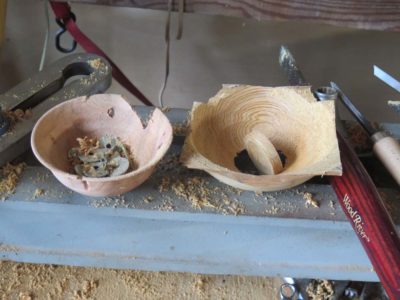
I found out that feathering the edge is not possible without reinforcing it somehow, probably by impregnating it with epoxy, or the edge will simply shatter as you work it. Ditto the base of the bowl where I did indeed find the edge of the envelope. I tried the a similar exercise with some figured plum stump I harvested 15 years ago. Same result.
Since failure is its own useful data point I now know I need to turn this form close to finished, then impregnate and finish up then. I will report back on those results.
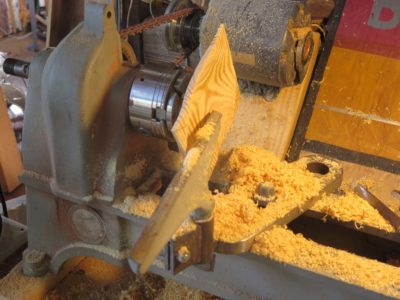
The next day I tried the exercise with a southern yellow pine scrap and also had encouraging results.

One of the peculiar and captivating phenomena of that attempt was the turning began to “sing” as the wall was thinned, sounding much like a crystal goblet when it is being played like a musical instrument.
Then, back to the Eames chair knockoff for more wordsmithing.
This afternoon I emailed the second of a great many sections of A Period Finisher’s Manual to my initial reviewers. I am trying to send them texts in their proper sequence even though that is not how I write them. This one was the introductory soliloquy on Surface Preparation (of wood). The surface preparation during the application of the finish will come much later.
My plan is to send another section every week or ten days, probably longer than today’s 1300 words. I know that the next one, the conclusion to Surface Preparation, is several times longer.
Many tens of thousands of words to get into the hands of the readers. I got my Eames Chair knockoff repaired so I’m good to go in massaging all these parts together.
A couple weeks ago I blogged over at Lost Art Press about the initial distribution of manuscript pieces for A Period Finisher’s Manual to my first-tier reviewers, four hearty volunteers who have pledged to stay with me to the bitter end. I assure you they will be just as tired of the project as I will be by the time it makes it into print. Thanks again Bill, Bob, Gina, and Josh for your yeoman’s work to make this esoteric topic into an engaging and informative volume.
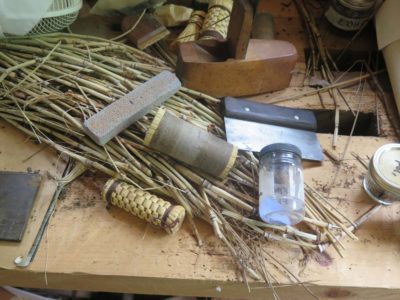
The first broadside was the “Introduction,” a non-technical roadmap for the project. Later this week I will be sending them at least part of (maybe the whole of) the first section, “Preparing the Surface.” There is nary a drum sander or jitterbug to be found.
I look forward to their feedback. Once it gets integrated into the manuscript text, that “final” version will be winging electronically to my second tier reviewers Bill, John, Len, and Mike for any final thoughts before the whole pile lands on The Schwarz’ desk. I have only so many words in me, so periodically I fall silent here as I restock the lexiconic inventory.
The only current unexpected hurdle is that a bolt on the rocker mechanism for my Eames knockoff chair broke on Friday so I have to get that fixed pronto. It’s my writing nest in The Waxerie, where I spend part of every day massaging words.
Have you ever encountered an instruction manual that was so poorly written that it left you more confused and less knowledgeable than when you started to read it? I have suffered through this experience many times, mostly with instruction manuals for electronics and compewder stuff. Frequently I have wondered why this is the case, and reached the conclusion that the reasons may be many, including:
What does this have to do with woodworking?
Well, I will soon be at the point in in writing The Period Finisher’s Manual where I am ready to begin sending out sections for review. I have the back half of the review covered, with my erudite friends MikeM and LenR volunteering to look at it from a technical/wordsmithing perspective. But they are highly skilled experienced finishers and are thus not the people to necessarily focus on what is not present in the text or visuals.
What I need is a small cadre of readers, preferably no more than two or three, who are literate but not so experienced in wood finishing that they can fall into the trap of Step #3. I need to know if the verbiage I am creating is actually comprehensible and useful to the less experienced finisher, such that they can read and understand what I am writing with the result being their ability to integrate what is in the book with what they are doing at the bench. Getting back to the compewder analogy, I encounter this whenever my webmeister or daughters give me some instruction for my laptop. I recognize that they are using English words but have no comprehension of what they mean.
These reviewers would not be paid, and their commitment to the project must be such that they will read critically and comment back to me in a timely manner so that I can make revisions as necessary. Creating a book is a long haul, often tedious and thankless. All I can offer is my public and private thanks and acknowledgement in the book, along with a couple copies of the book itself once finished, and perhaps a nice gift basket of wood finishing swag from The Barn On White Run. Oh, and a substantial credit in the Bank of Don, previous beneficiaries of which I hope would confirm is not without value.
If this sounds like you, let me know. If you have my email, use it. If not, try the Contact function on the web site. If that is being temperamental leave a Comment to this post, these remain private until I review and post them so you can leave your contact information with confidence that it will remain private.
Over the last few weeks I’ve been cleaning and organizing/reorganizing my studio, resulting in a more compact spatial scheme and, thus a space for my secret weapon in writing. Yup, I brought down my secret mojo into the studio to psyche me into attacking the completion of A Period Finisher’s Manual with gusto.
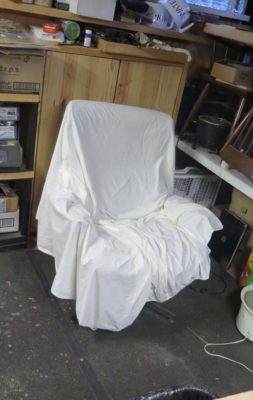
Sure, it is a raggedy third generation Eames knock-off (here draped in an old sheet to keep it clean-ish) but it is perhaps the most comfortable chair I’ve ever owned. It would be interesting to know the dimensions of Charles Eames’ physique because the chair fits me as though it had been custom-made for me. It’s sorta like a friend of mine, an armorer and devotee of Sig Sauer pistols, who tells me they fit him like a glove. Indeed S-S are superb precision tools, but the secret sauce to that recipe is that my friend is literally the hand model for the tool — of course he thinks they fit him perfectly, because they were designed to fit his own hand!
Anyway, I have already begun to work on revising the APFM manuscript with vengeance as I am simply tired of having it hanging over my head. Michele has advanced far ahead of me on the Roubo front so I need to get this one done and turn my attention to catching up with her.

I’m hoping this mojo works as well as in the past, when I could work expediently on a manuscript in my chair (even with cats draped allover me while I was revising Roubo 1).
Recent Comments